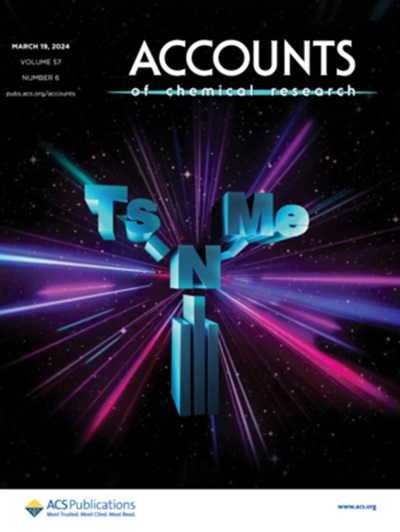解释质子耦合电子转移反应中的动力学同位素效应
IF 17.7
1区 化学
Q1 CHEMISTRY, MULTIDISCIPLINARY
引用次数: 0
摘要
质子耦合电子转移(PCET)对多种化学和生物过程至关重要。了解 PCET 反应的机理对于控制和调整这些过程非常重要。动能同位素效应(KIE)被定义为氢和氘转移的速率常数之比,它被用来在实验中探究 PCET 的机理,但往往难以解释。本文介绍了一种解释协同 PCET 反应 KIE 的理论框架。第一步是根据振动和电子-质子非绝热性对反应进行分类,它们反映了电子、质子和环境的相对时间尺度。第二步是根据这一分类选择合适的速率常数表达式。第三步是用计算方法计算输入量。本文章由计算机程序翻译,如有差异,请以英文原文为准。

Explaining Kinetic Isotope Effects in Proton-Coupled Electron Transfer Reactions
Proton-coupled electron transfer (PCET) is essential for a wide range of chemical and biological processes. Understanding the mechanism of PCET reactions is important for controlling and tuning these processes. The kinetic isotope effect (KIE), defined as the ratio of the rate constants for hydrogen and deuterium transfer, is used to probe PCET mechanisms experimentally but is often challenging to interpret. Herein, a theoretical framework is described for interpreting KIEs of concerted PCET reactions. The first step is to classify the reaction in terms of vibronic and electron–proton nonadiabaticities, which reflect the relative time scales of the electrons, protons, and environment. The second step is to select the appropriate rate constant expression based on this classification. The third step is to compute the input quantities with computational methods.
求助全文
通过发布文献求助,成功后即可免费获取论文全文。
去求助
来源期刊

Accounts of Chemical Research
化学-化学综合
CiteScore
31.40
自引率
1.10%
发文量
312
审稿时长
2 months
期刊介绍:
Accounts of Chemical Research presents short, concise and critical articles offering easy-to-read overviews of basic research and applications in all areas of chemistry and biochemistry. These short reviews focus on research from the author’s own laboratory and are designed to teach the reader about a research project. In addition, Accounts of Chemical Research publishes commentaries that give an informed opinion on a current research problem. Special Issues online are devoted to a single topic of unusual activity and significance.
Accounts of Chemical Research replaces the traditional article abstract with an article "Conspectus." These entries synopsize the research affording the reader a closer look at the content and significance of an article. Through this provision of a more detailed description of the article contents, the Conspectus enhances the article's discoverability by search engines and the exposure for the research.
 求助内容:
求助内容: 应助结果提醒方式:
应助结果提醒方式:


